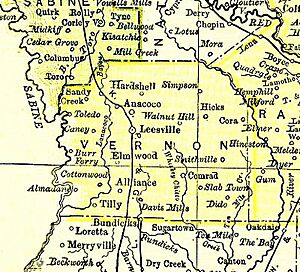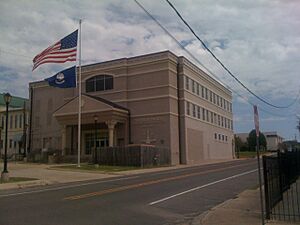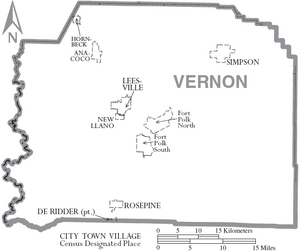Vernon Parish, Louisiana facts for kids
Quick facts for kids
Vernon Parish, Louisiana
|
|
|---|---|
| Parish of Vernon | |
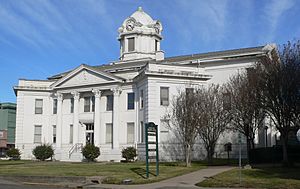
Vernon Parish courthouse in Leesville
|
|
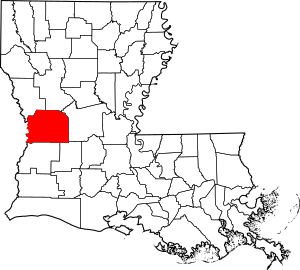
Location within the U.S. state of Louisiana
|
|
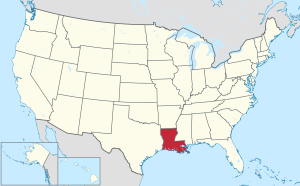
Louisiana's location within the U.S.
|
|
| Country | |
| State | |
| Region | Central Louisiana |
| Founded | March 30, 1871 |
| Named for | Mount Vernon |
| Parish seat | Leesville |
| Largest municipality | Simpson (area) Leesville (population) |
| Incorporated municipalities |
6 (total)
1 city, 3 towns, and 2 villages
(located entirely or partially within parish boundaries) |
| Area | |
| • Total | 3,470 km2 (1,341 sq mi) |
| • Land | 3,440 km2 (1,328 sq mi) |
| • Water | 40 km2 (14 sq mi) |
| • percentage | 3 km2 (1.0 sq mi) |
| Population
(2020)
|
|
| • Total | 48,750 |
| • Density | 14.036/km2 (36.353/sq mi) |
| Time zone | UTC-6 (CST) |
| • Summer (DST) | UTC-5 (CDT) |
| Area code | 337 |
| Congressional district | 4th |
Vernon Parish (which is Paroisse de Vernon in French) is a special kind of county in the U.S. state of Louisiana. In 2020, about 48,750 people lived there. The main town and biggest city is Leesville.
The parish is on the western side of Louisiana, next to the Sabine River. It was created in 1871, right after the Reconstruction era in American history. For a long time, the main business here was the timber industry. People harvested pine trees from the hills and hardwood trees from the lowlands. When a railway was built in 1897, it helped the lumber business grow even more.
After World War II, a big military base called Fort Johnson (it used to be Fort Polk) became very important for the parish's economy. When the fort opened, the number of people living in the Leesville area quickly grew five times bigger! Vernon Parish is part of a larger area that includes Fort Johnson South and DeRidder.
Contents
History of Vernon Parish
On March 30, 1871, the Louisiana government decided to create Vernon Parish. They took land from three other parishes: Natchitoches, Rapides, and Sabine.
How Vernon Parish Got Its Name
The official story is that Vernon Parish was named after Mount Vernon, which was the home of George Washington. But there are also some fun, unofficial stories about how it got its name:
- One story says it was named after a fast racehorse owned by Joe Moore. He was on the committee to name the parish. He thought naming it after his speedy horse would make the parish grow just as fast!
- Another story tells of a popular teacher named "Mr. Vernon." He was an officer in the Royal Navy. The committee members couldn't agree on a name, so they picked "Vernon" to avoid arguments.
- A third story is similar to the horse one. It says the committee was arguing while drinking in a store. The store owner, wanting them to leave, suggested they ask the next person they saw what they would name something. A man with a mule cart came by. When asked, he said, "I calls him Vernon, 'cause he's the fastes' mule in de country."
Early Days and the Neutral Strip
Before the Louisiana Purchase in 1803, the land that is now Vernon Parish was part of a disputed area. Both the United States and Spain claimed it. This area was called the "Neutral Strip". Because no one really controlled it, it became a hiding place for outlaws.
Before 1803, only a few French and Spanish settlers lived here. During this time, a man named Dr. Timothy Burr started a community called Burr Ferry. This place was known as the "Gateway to Louisiana". Near Burr Ferry, you can still see an old artillery site. It was used by the Confederate army during the American Civil War to guard against Union soldiers.
Leesville: The Parish Seat
Leesville has been the main town of Vernon Parish since it was created. However, it didn't officially become a city until 1900. Dr. Edmund E. Smart founded the city. His father, Senator John Rowell Smart, named it after General Robert E. Lee.
When Leesville was founded, it was the site of Dr. Smart's plantation. The house from that plantation is still standing today at the corner of Lula and First Street.
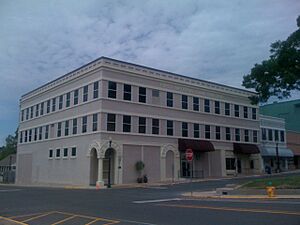
Timber and Railways
In the late 1890s, the timber industry really took off in Vernon Parish. This was thanks to the arrival of the Kansas City Southern Railway in 1897. This railway is still used today!
Unique Communities
After World War I, Vernon Parish became home to two interesting communities based on socialist ideas. These were the Llano del Rio Cooperative Colony (which later became New Llano) and the Christian Commonwealth Colony. These groups tried to create places where people shared work and resources. Llano del Rio was the biggest, with over 10,000 people, and it lasted the longest. Both colonies ended in the 1930s when the Great Depression hit.
Fort Johnson's Impact
In 1941, the United States Army opened Camp Polk. This happened shortly after military training exercises in 1939-40. Camp Polk quickly became more important to the parish's economy than the timber industry. This was clear in Leesville, where the population jumped from 3,500 to 18,000 after the camp opened.
The camp was named after Leonidas Polk. He was the first Episcopal Bishop in Louisiana and was known as the "Fighting Bishop of the Confederacy." Camp Polk was a major training camp during World War II. Today, it's called Fort Johnson and is one of the largest military bases in the nation. It covers about 200,000 acres (800 square kilometers). Because soldiers and their families constantly move in and out, Vernon Parish has a mix of cultures from many different states and countries. It's a true "melting pot"!
Geography of Vernon Parish
Vernon Parish covers a total area of about 1,341 square miles. Most of this (1,328 square miles) is land, and about 14 square miles (1.0%) is water. It is the largest parish in Louisiana by land area.
Main Roads
Neighboring Areas
Vernon Parish shares borders with several other parishes and counties:
- Sabine Parish (to the northwest)
- Natchitoches Parish (to the north)
- Rapides Parish (to the east)
- Allen Parish (to the southeast)
- Beauregard Parish (to the south)
- Newton County, Texas (to the west)
Protected Natural Areas
Part of the Kisatchie National Forest is located within Vernon Parish.
Population and People
| Historical population | |||
|---|---|---|---|
| Census | Pop. | %± | |
| 1880 | 5,160 | — | |
| 1890 | 5,903 | 14.4% | |
| 1900 | 10,327 | 74.9% | |
| 1910 | 17,384 | 68.3% | |
| 1920 | 20,493 | 17.9% | |
| 1930 | 20,047 | −2.2% | |
| 1940 | 19,142 | −4.5% | |
| 1950 | 18,974 | −0.9% | |
| 1960 | 18,301 | −3.5% | |
| 1970 | 53,794 | 193.9% | |
| 1980 | 53,475 | −0.6% | |
| 1990 | 61,961 | 15.9% | |
| 2000 | 52,531 | −15.2% | |
| 2010 | 52,334 | −0.4% | |
| 2020 | 48,750 | −6.8% | |
| U.S. Decennial Census 1790–1960 1900–1990 1990–2000 2010 |
|||
| Race | Number | Percentage |
|---|---|---|
| White (non-Hispanic) | 33,599 | 68.92% |
| Black or African American (non-Hispanic) | 6,325 | 12.97% |
| Native American | 484 | 0.99% |
| Asian | 862 | 1.77% |
| Pacific Islander | 289 | 0.59% |
| Other/Mixed | 3,016 | 6.19% |
| Hispanic or Latino | 4,175 | 8.56% |
In 2020, there were 48,750 people living in Vernon Parish. These people lived in 17,696 households, and 12,375 of those were families.
Education in Vernon Parish
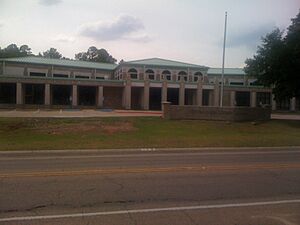
Schools for Kids and Teens
All public schools in Vernon Parish are run by the Vernon Parish School Board. They manage 18 public schools and one optional school.
Here are some of the schools that offer secondary education (middle and high school):
- Evans High School (Grades PK-12)
- Hicks High School (Grades PK-12)
- Hornbeck High School (Grades PK-12)
- Pitkin High School (Grades PK-12)
- Simpson High School (Grades PK-12)
- Anacoco High School (Grades 7–12)
- Pickering High School (Grades 7–12)
- Rosepine Junior/Senior High School (Grades 7–12)
- Leesville High School (Grades 9–12)
- Vernon Parish Optional School (Grades 7–12)
- Faith Training Christian Academy (private school for K4-12)
Colleges and Universities
There are several options for higher education in or near Vernon Parish:
- The Louisiana Technical College (LTC) system has a campus called Lamar Salter south of New Llano. It's one of 40 LTC campuses in the state.
- Northwestern State University (NSU) is a four-year public university. Its main campus is in Natchitoches, Louisiana. The NSU-Leesville/Fort Johnson Campus is located near Fort Johnson. It serves students from Vernon, Beauregard, and Sabine parishes, as well as military families at Fort Johnson.
- The Fort Johnson Education Center helps military members, their families, and local civilians. They offer classes in person, online, and through distance learning.
- Central Michigan University (CMU) also has a campus at Fort Johnson.
- Central Texas College (CTC) is a community college that offers associate degrees and certificate programs. Because it's close to Fort Johnson, CTC has become very helpful for military students.
- Louisiana State University offers a Master of Arts in Liberal Arts program.
- The Upper Iowa University (UIU) at Fort Johnson offers classes to both military personnel and civilians. It opened in 1995 and offers bachelor's degrees in many subjects.
Public Libraries
The Vernon Parish Library system runs the public libraries. This includes the main library and the Dunbar Branch Library in Leesville, and the Pitkin Branch Library in Pitkin.
National Guard Presence
The Louisiana Army National Guard has a maintenance facility at Fort Polk. They use it to service their vehicles. The 3-156 IB, which is part of the 256th Tiger Brigade, is also located at Fort Polk.
Communities in Vernon Parish
Cities
Towns
Villages
Census-Designated Places
These are areas that are like towns but are not officially incorporated.
Unincorporated Communities
These are smaller communities that are not officially part of a city, town, or village.
Famous People from Vernon Parish
Many notable people have connections to Vernon Parish:
- Bert A. Adams served as a state representative for Vernon Parish from 1956 to 1968.
- Eddie Fuller was a running back for the Buffalo Bills football team.
- Frank A. Howard was a former sheriff of Vernon Parish and a Republican member of the Louisiana House of Representatives.
- Buddy Leach was a member of the United States House of Representatives and the Louisiana House of Representatives. He also chaired the Louisiana Democratic Party.
- Kevin Mawae was an All-Pro center for the Tennessee Titans football team.
- Demond Mallet is a professional basketball player who played in the German League and with Joventut Badalona.
- Jim McCrery was a former U.S. Representative for Louisiana's 4th congressional district.
- Charles M. Poston, Sr. was a member of the Louisiana State Senate from 1960 to 1964.
- Bryan A. Poston was a member of the Louisiana State Senate from 1964 to 1992.
- Jewel Prestage was the first African-American woman to earn a PhD in political science. She was also a former Dean at Southern University.
- D'Anthony Smith was a nose tackle for the Chicago Bears football team.
See also
 In Spanish: Parroquia de Vernon para niños
In Spanish: Parroquia de Vernon para niños


